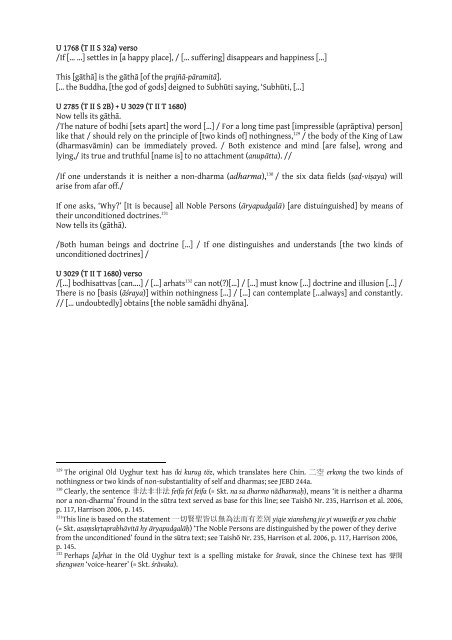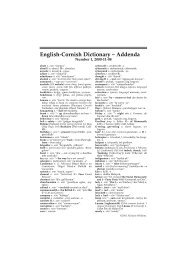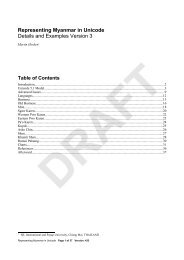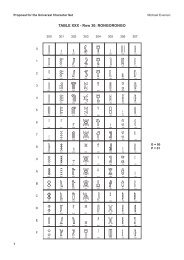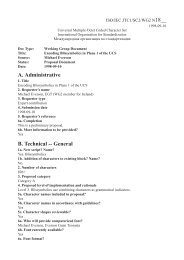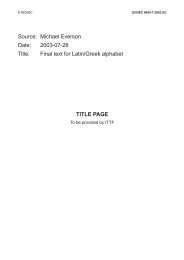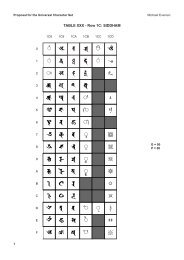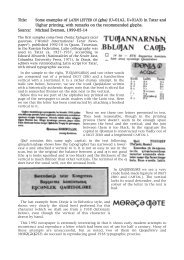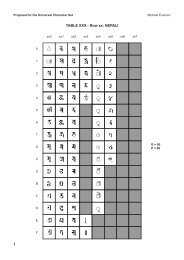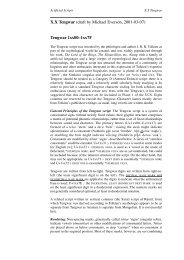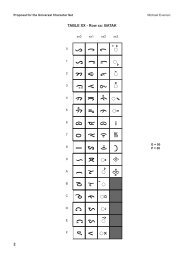The Vajracchedikā-sūtra with gāthās compiled by Master Fu - Evertype
The Vajracchedikā-sūtra with gāthās compiled by Master Fu - Evertype
The Vajracchedikā-sūtra with gāthās compiled by Master Fu - Evertype
Create successful ePaper yourself
Turn your PDF publications into a flip-book with our unique Google optimized e-Paper software.
U 1768 (T II S 32a) verso<br />
/If [… …] settles in [a happy place], / [… suffering] disappears and happiness […]<br />
This [gāthā] is the gāthā [of the prajñā-pāramitā].<br />
[… the Buddha, [the god of gods] deigned to Subhūti saying, ‘Subhūti, […]<br />
U 2785 (T II S 2B) + U 3029 (T II T 1680)<br />
Now tells its gāthā.<br />
/<strong>The</strong> nature of bodhi [sets apart] the word […] / For a long time past [impressible (aprāptiva) person]<br />
like that / should rely on the principle of [two kinds of] nothingness, 129 / the body of the King of Law<br />
(dharmasvāmin) can be immediately proved. / Both existence and mind [are false], wrong and<br />
lying,/ its true and truthful [name is] to no attachment (anupātta). //<br />
/If one understands it is neither a non-dharma (adharma), 130 / the six data fields (ṣaḍ-viṣaya) will<br />
arise from afar off./<br />
If one asks, ‘Why?’ [It is because] all Noble Persons (āryapudgalā) [are distuinguished] <strong>by</strong> means of<br />
their unconditioned doctrines. 131<br />
Now tells its (gāthā).<br />
/Both human beings and doctrine […] / If one distinguishes and understands [the two kinds of<br />
unconditioned doctrines] /<br />
U 3029 (T II T 1680) verso<br />
/[…] bodhisattvas [can….] / […] arhats 132 can not(?)[…] / […] must know […] doctrine and illusion […] /<br />
<strong>The</strong>re is no [basis (āśraya)] <strong>with</strong>in nothingness […] / […] can contemplate […always] and constantly.<br />
// [… undoubtedly] obtains [the noble samādhi dhyāna].<br />
129<br />
<strong>The</strong> original Old Uyghur text has iki kurug töz, which translates here Chin. 二 空 erkong the two kinds of<br />
nothingness or two kinds of non-substantiality of self and dharmas; see JEBD 244a.<br />
130<br />
Clearly, the sentence 非 法 非 非 法 feifa fei feifa (= Skt. na sa dharmo nādharmaḥ), means ‘it is neither a dharma<br />
nor a non-dharma’ fround in the <strong>sūtra</strong> text served as base for this line; see Taishō Nr. 235, Harrison et al. 2006,<br />
p. 117, Harrison 2006, p. 145.<br />
131 This line is based on the statement 一 切 賢 聖 皆 以 無 為 法 而 有 差 別 yiqie xiansheng jie yi wuweifa er you chabie<br />
(= Skt. asaṃskṛtaprabhāvitā hy āryapudgalāḥ) ‘<strong>The</strong> Noble Persons are distinguished <strong>by</strong> the power of they derive<br />
from the unconditioned’ found in the <strong>sūtra</strong> text; see Taishō Nr. 235, Harrison et al. 2006, p. 117, Harrison 2006,<br />
p. 145.<br />
132 Perhaps [a]rhat in the Old Uyghur text is a spelling mistake for šravak, since the Chinese text has 聲 聞<br />
shengwen ‘voice-hearer’ (= Skt. śrāvaka).


